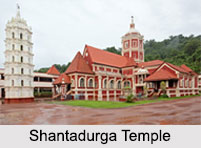 Shantadurga Temple is a private temple complex belonging to Gour Saraswat Brahmins (GSB) community in Goa. The presiding goddess is Shantadurga worshiped in the form of Vishweshwari. The goddess is also called "Santeri" colloquially. Shantadurga is revealed as holding two serpents, one in each hand, symbolizing Vishnu and Shiva. This beautiful temple is set amidst betel palms and is also known as the "Santeri Temple".
Shantadurga Temple is a private temple complex belonging to Gour Saraswat Brahmins (GSB) community in Goa. The presiding goddess is Shantadurga worshiped in the form of Vishweshwari. The goddess is also called "Santeri" colloquially. Shantadurga is revealed as holding two serpents, one in each hand, symbolizing Vishnu and Shiva. This beautiful temple is set amidst betel palms and is also known as the "Santeri Temple".
Location of Shantadurga Temple
Shri Shantadurga Temple is situated at the peak of Kavalem village in Ponda Taluka, Goa. The temple is located 33 kilometres away from Panaji, the capital city of Goa.
History of Shantadurga Temple
The deity of the temple, Shanta Durga is a form of Goddess Parvati, the wife of Lord Shiva. Being the most powerful of all goddesses, she also takes on a violent form and is then referred to as Durga. According to a legend, once during a quarrel between Lord Shiva and Lord Vishnu, she appeared in the form of Durga and helped to resolve their fight. In the Sanskrit language, "Shanta" means "peace". Thus by combining the two names, emerged the name Shantadurga, who has now come to be the Goddess of Peace. The temple was built in 1738 by king Shahu of Satara is the largest and most famous temple in Goa.
Architecture of Shantadurga Temple
The beautiful idol of Goddess Shree Shanta Durga has a 6 inch coloured Shivalinga adjacent to it. The temple is well-equipped with "Agrashalas" and accommodated with modern facilities and multiple halls. The temple has a beautiful "Garbhakuda" where the idol is kept. The temple was built in 1738 during the reign of Maratha king Shahu Raje of Satara at the request of Naro Ram Mantri. It is one of the main attractions of Goa that attracts devotees from far and near.
The Shivalinga at the temple is considered as belonging to the "Mahajans" of the surname `Vorde` who are "Kulavis" of the Shri Manguesha Temple. The goddess is said to have to Shankawali to kill the demons harassing the Brahmins there. It is for this good deed that she also earned the name of "Vijaya".
Festivals of Shantadurga Temple
Following are the chief Festivals of Shantadurga Temple:
•Shishirotsav (popularly known as Shigmo). It is a 10-day celebration and includes procession of deities in different Vahanas with other rituals like kalotsav, Homa, Dhwajarohana, Gulalotsava, Rathotsava, etc.
•Navaratri.
•Vasant Panchami.
•Akshay Tritiya.
•Shravani somvar. The First Shravani Somvar is celebrated by Desai of Desai wada, Pirna, Bardez, Goa.
•Dussehra.
•Jatra.











